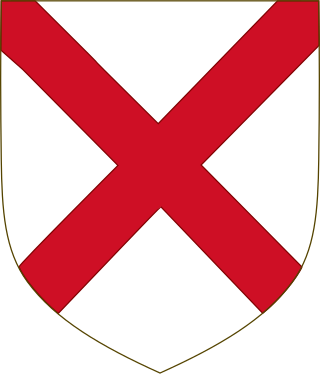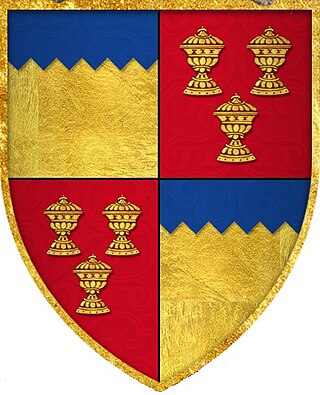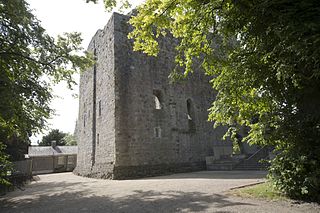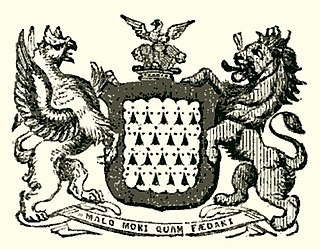Related Research Articles
Conn Bacagh O'Neill, 1st Earl of Tyrone, was king of Tyrone. In 1541 O'Neill travelled to England to submit to Henry VIII as part of the surrender and regrant policy that coincided with the creation of the Kingdom of Ireland. He was made Earl of Tyrone, but his plans to pass the title and lands on to a chosen successor Matthew were thwarted by a violent succession dispute that led to another son, Shane O'Neill, emerging triumphant.
The Lord High Chancellor of Ireland was the highest judicial office in Ireland until the establishment of the Irish Free State in 1922. From 1721 to the end of 1800, it was also the highest political office of the Irish Parliament: the Chancellor was Speaker of the Irish House of Lords. The Lord Chancellor was also Lord Keeper of the Great Seal of Ireland. In all three respects, the office mirrored the Lord High Chancellor of Great Britain.

The FitzGerald dynasty is a Hiberno-Norman noble and aristocratic dynasty, originally of Cambro-Norman and Anglo-Norman origin. They have been peers of Ireland since at least the 13th century, and are described in the Annals of the Four Masters as having become "more Irish than the Irish themselves" or Gaels, due to assimilation with the native Gaelic aristocratic and popular culture. The dynasty has also been referred to as the Geraldines and Ireland's largest landowners. They achieved power through colonisation and the conquest of large swathes of Irish territory by the sons and grandsons of Gerald de Windsor. Gerald de Windsor was the first Castellan of Pembroke Castle in Wales, and became the male progenitor of the FitzMaurice and FitzGerald Dynasty. His father, Baron Walter FitzOther, was the first Constable and Governor of Windsor Castle for William the Conqueror, and was the Lord of 38 manors in England, making the FitzGeralds one of the "service families" on whom the King relied for his survival. Some of its members became the Black Knights, Green Knights and White Knights.

Thomas FitzGerald, 10th Earl of Kildare, also known as Silken Thomas, was a leading figure in 16th-century Irish history.

Piers Butler, 8th Earl of Ormond, 1st Earl of Ossory also known as Red Piers, was from the Polestown branch of the Butler family of Ireland. In the succession crisis at the death of Thomas Butler, 7th Earl of Ormond he succeeded to the earldom as heir male, but lost the title in 1528 to Thomas Boleyn. He regained it after Boleyn's death in 1538.
Alexander Plunket was an Irish statesman and judge of the fifteenth century.

Gerald FitzGerald, 11th Earl of Kildare, also known as the "Wizard Earl", was an Irish peer. He was the son of Gerald FitzGerald, 9th Earl of Kildare and his second wife Elizabeth Grey of the Royal House of Grey.

Tír Eoghain, also known as Tyrone, was a kingdom and later earldom of Gaelic Ireland, comprising parts of present-day County Tyrone, County Armagh, County Londonderry and County Donegal (Raphoe). The kingdom represented the core homeland of the Cenél nEógain people of the Northern Uí Néill and although they ruled, there were smaller groups of other Gaels in the area. One part of the realm to the north-east broke away and expanded, becoming Clandeboye, ruled by a scion branch of the O'Neill dynasty. In one form or another, Tyrone existed for over a millennium. Its main capital was Dungannon, though kings were inaugurated at Tullyhogue Fort.
Events from the year 1534 in Ireland.
Maurice FitzThomas FitzGerald, 4th Earl of Kildare was a prominent Irish nobleman in the Peerage of Ireland who held the office of Lord Justice of Ireland.
John Alen was an English priest and canon lawyer, whose later years were spent in Ireland. He held office as Archbishop of Dublin and Lord Chancellor of Ireland, and was a member of the Privy Council of Ireland. In the latter office, for a few years, he played a central role in the government of Ireland.

Thomas FitzJohn FitzGerald, 7th Earl of Kildare, was an Irish peer and statesman of the fifteenth century who held the office of Lord Chancellor of Ireland.

John Barnewall, 3rd Baron Trimleston, was an Irish nobleman, judge and politician. He was the eldest son of Christopher Barnewall, 2nd Baron Trimlestown and his wife Elizabeth Plunket, daughter of Sir Thomas Fitz-Christopher Plunket of Rathmore, Lord Chief Justice of the King's Bench in Ireland and his second wife Marian Cruise. He succeeded his father as 3rd Baron in about 1513. His father, like most of the Anglo-Irish aristocracy, had supported the claim of the pretender Lambert Simnel to the English throne in 1487. After the failure of Simnel's rebellion, he received a royal pardon.
Sir Thomas FitzGerald of Laccagh (c.1458–1487) was an Irish lawyer, statesman and soldier who was Lord Chancellor of Ireland under Richard III and Henry VII, but rebelled against Henry and was killed at the Battle of Stoke.
Sir John Alan was a leading English-born statesman in sixteenth century Ireland. He was a member of the Irish House of Commons, and held the offices of Master of the Rolls in Ireland, Chancellor of the Exchequer of Ireland and Lord Chancellor of Ireland. Though he was childless himself, one of his brothers, William, founded a prominent landowning dynasty in County Kildare. The family's holdings included lands at Celbridge, St. Wolstan's and Kilteel, County Kildare, as well as substantial lands in County Dublin. They also acquired a baronetcy.
Richard Delahide was an Irish judge of the sixteenth century, who held the offices of Chief Justice of the Irish Common Pleas and Chief Baron of the Irish Exchequer. His career was seriously damaged by the Rebellion of Silken Thomas, in which several members of his family played a leading part, and he was fortunate to escape permanent disgrace.
Sir Simon Fitz-Richard was an Irish landowner, barrister and judge. He became Chief Justice of the Irish Common Pleas, and fought a long and successful campaign against the efforts of his enemies to remove him from office, despite the numerous accusations of corruption which were made against him.

Gerald FitzGerald, 8th Earl of Kildare KG, known variously as "Garret the Great" or "The Great Earl", was Ireland's premier peer. He served as Lord Deputy of Ireland from 1477 to 1494, and from 1496 onward. His power was so great that he was called "the uncrowned King of Ireland".
Sir Thomas Plunket (c.1440–1519) was a wealthy Irish landowner, lawyer and judge in fifteenth-century and early sixteenth-century Ireland. He held office as Chief Baron of the Irish Exchequer and Chief Justice of the Irish Common Pleas. After the change of the English royal family in 1485, his loyalty to the new Tudor dynasty was deeply suspect, and he was involved in two attempts to put a pretender on the English throne. On each occasion he was disgraced, fined and removed from office; yet he had sufficient political influence to ensure his return to favour and high office.
Sir James Keating was an Irish cleric and statesman of the fifteenth century. He was Prior of the Irish house of the Knights Hospitallers, which was based at Kilmainham, Dublin, and a member of the Privy Council of Ireland.
References
- Chapter in A.J. Hughes, William Nolan (eds.) (2001), Armagh: Interdisciplinary essays on the History of an Irish County
- Ball, F. Elrington The Judges in Ireland 1221–1921 London John Murray 1926